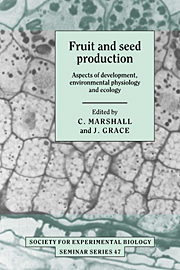Book contents
- Frontmatter
- Contents
- Contributors
- Preface
- Plant reproductive biology: an overview
- The environmental control of reproductive development
- Pollination and fertilization in higher plants
- Embryogenesis
- Environmental and internal regulation of fruiting, with particular reference to Cox's Orange Pippin apple
- Fruit growth and sink strength
- Control of grain growth and development
- The regulation of maternal investment in plants
- Ecological and physiological aspects of reproductive allocation
- Are the distributions of species determined by failure to set seed?
- Edible fruits in a cool climate: the evolution and ecology of endozoochory in the European flora
- Index
Environmental and internal regulation of fruiting, with particular reference to Cox's Orange Pippin apple
Published online by Cambridge University Press: 04 August 2010
- Frontmatter
- Contents
- Contributors
- Preface
- Plant reproductive biology: an overview
- The environmental control of reproductive development
- Pollination and fertilization in higher plants
- Embryogenesis
- Environmental and internal regulation of fruiting, with particular reference to Cox's Orange Pippin apple
- Fruit growth and sink strength
- Control of grain growth and development
- The regulation of maternal investment in plants
- Ecological and physiological aspects of reproductive allocation
- Are the distributions of species determined by failure to set seed?
- Edible fruits in a cool climate: the evolution and ecology of endozoochory in the European flora
- Index
Summary
Introduction
In many species, there is a long period from flower induction to fruit ripening and abscission, during which environmental factors can have a major impact on the success of fruiting. This is particularly so with perennial crops such as pome, stone and citrus fruits, where even the period just from anthesis to ripening can last up to 60 weeks (Valencia orange). It is not surprising, therefore, that there are several opportunities for adverse environmental conditions to lead to reduced fruit numbers at harvest. For example, flower abortion before anthesis can result from low light levels (e.g. tomato) (Kinet et al., 1978), frost damage (e.g. pome fruits) (Modlibowska, 1964), water deficit (e.g. Vicia faba L.) (El-Nadi, 1969) and water excess (e.g. Vicia faba L.) (Smith, 1982), while shading can precipitate the drop of enlarging fruits (e.g. peach and apple) (Byers et al., 1985) and wind can exacerbate the pre-harvest drop of pome fruits. Flower and fruit abortion has been reviewed by Stephenson (1981) and will not be the major topic of this chapter.
Although environmental factors can affect fruiting pre-anthesis and after the initial set has taken place, by far the most important period determining the success of fruiting comprises the few days during and after flower opening, when the transition from flower to fruitlet takes place. This, of course, is not surprising since it is also the time when the reproductive competitiveness of the maternal genome is partly determined through the success of fertilization and subsequent seed dispersal.
- Type
- Chapter
- Information
- Fruit and Seed ProductionAspects of Development, Environmental Physiology and Ecology, pp. 75 - 100Publisher: Cambridge University PressPrint publication year: 1992
- 10
- Cited by



